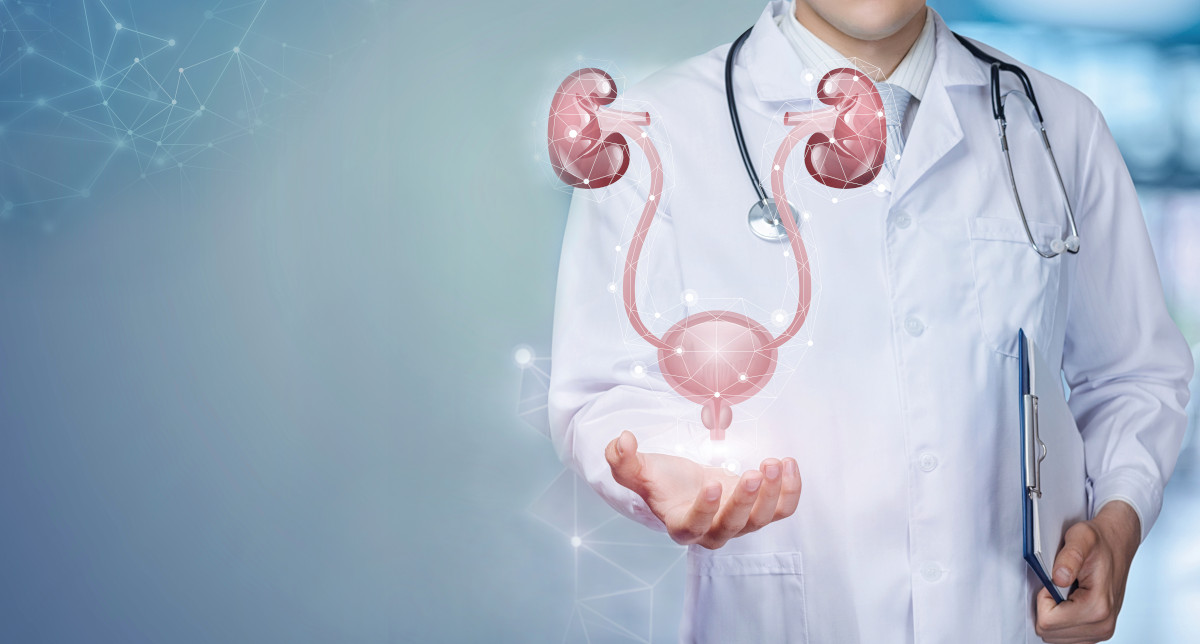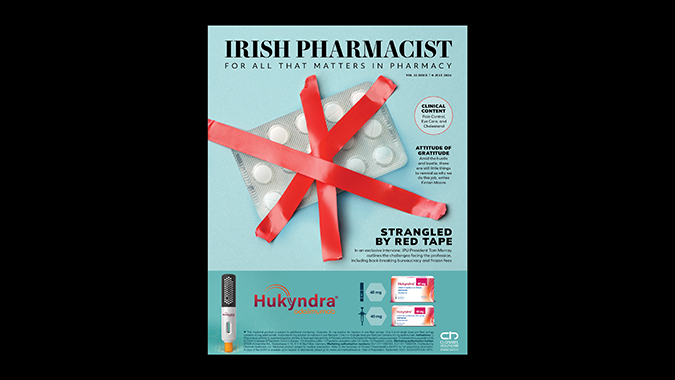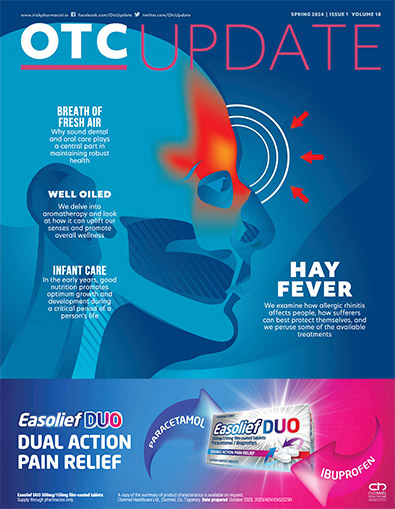Eamonn Brady MPSI provides a clinical overview of benign prostatic hyperplasia, a commonly-occurring and
under-reported condition in a large number of men as they age
Benign prostatic hyperplasia (BPH), also known as prostate gland enlargement, is a common condition as men age. An enlarged prostate can cause restriction in the flow of urine from the bladder, which, if left untreated, may lead to further complications relating to the urinary tract, bladder and kidneys.
It is estimated to affect over 30 million men to a significant degree worldwide, but the actual number is likely to be a lot higher due to under-reporting. In terms of age range, BPH affects 33 per cent of men aged over 50, rising to 50 per cent in those aged over 60 and to 90 per cent by age 85.
There is some evidence to suggest that, for a variety of reasons, the numbers at the younger end of the range are under-reported, with many taking the view on early symptoms they may be experiencing as ‘just part of getting older’ and as such, don’t take any action until later, when symptoms get worse.
BPH is a normal facet of getting older and whilst it’s not usually a serious health risk, it’s important that those with even mild symptoms have them investigated early, if only just to rule out anything more serious. If left untreated, as symptoms develop, BPH can have a significant impact on a patient’s health and quality of life.
Predictive risk factors for BPH are obviously age, however other factors such as obesity or a family history of prostate issues, along with those living with diabetes or heart disease, may have an increased risk. Early diagnosis, intervention and regular monitoring can be of significant benefit to the successful management of the condition.
Once diagnosed, depending on the outcomes, there are a range of treatments, therapies or procedures that can be considered and will help alleviate symptoms or cure the condition. The specific cause of BPH and what causes the prostate to enlarge are not entirely known, however, it is generally thought to be related to changes in the balance of sex hormone (particularly testosterone) in a man’s body as he gets older.
Why is prostate gland enlargement a problem?
The prostate gland is a walnut-sized gland which sits under the bladder. The urethra, the tube which conduits urine from the bladder to the penis, passes through the prostate gland. As the prostate gland enlarges, its outward growth is restricted by the walls of the gland itself, which in turn causes the two sides of the prostate to compress the urethra in the middle. It is this compression and its subsequent restriction on the urinary system that then causes the various symptoms associated with BPH. That is a rudimentary description of what happens. In real terms, it’s down to the physiology of the individual concerned, so it doesn’t necessarily follow that the size of the prostate itself determines how severe the symptoms are; some with only a slight enlargement of the gland may have significant symptoms, and vice-versa.
Many men believe that there is some correlation between an enlarged prostate and prostate cancer. For reference, there is no relation in terms of the condition itself; the risk for prostate cancer is the same, irrespective of whether BPH is present or not.
The GP will ask general questions relating to lifestyle, quality of life and more specific questions relating to the symptoms the patient has. Following this discussion, it is likely the GP will conduct a physical examination, which will include a digital rectal exam. Inserting a finger into the rectum and feeling the prostate through the rectum wall will give the doctor information on the size, shape and feel of the prostate.
It is also likely that the GP will ask for a urine test to identify possible infections and also a blood test. The blood test will help identify any kidney issues and give a PSA (prostate-specific antigen) score, which will help benchmark/rule out any potential prostate cancer issues. If there is any concern regarding cancer, the GP will refer to urology straight away.
Once all the relevant information has been collated, the GP will either be able to offer a diagnosis, or if further clarity is needed, recommend further tests. These are more likely to be in a hospital setting. Once BPH has been diagnosed, depending on personal factors such as prostate size, the patient’s age and general health, along with severity of symptoms or more often, impact on quality of life, a course of action will be taken.
If the symptoms are mild or not that bothersome, the term ‘watchful waiting’ may be introduced to monitor and manage a patient’s symptoms using regular screening (quarterly usually) of previously benchmarked results.
Again, with mild symptoms, some simple lifestyle changes may help manage and alleviate them. These may include:
? Usual advice regarding diet and exercise, especially if obesity is an issue, which can affect BPH. Specific exercises may be given to help with breathing, relaxation and muscle control (pelvic floor).
? Minimising consumption of carbonated drinks, alcohol, caffeine and artificial sweeteners will reduce the risk of
bladder irritation.
? Where nocturia is an issue, reducing fluid intake in the evening and drinking nothing two hours prior to bedtime may help to avoid night-time toilet visits.
? Be prepared — if the patient is embarking on a long journey or isn’t sure about toilet access, they should be prepared by using the toilet before leaving.
? Double-voiding — waiting for a few minutes when the patient has ‘finished’ before trying to go again. This will help those who have difficulty in emptying their bladder.
? Increasing fibre intake can help promote more regular bowel movements. Constipation can put pressure on the bladder and aggravate symptoms.
? Review current medication regimen to ensure there is no adverse impact on urinary symptoms.
Once BPH has been diagnosed, depending on personal factors such as prostate size, the patient’s age and general health, along with severity of symptoms or more often, impact on quality of life, a course of action will be taken
Symptoms and signs
As discussed previously, this compression of the urethra results in
common signs and symptoms of BPH, which, if left undiagnosed and untreated, will worsen over time. A good analogy for what is happening physically with BPH would be if you have ever used a hose to water your garden or wash the car. If someone was to stand on the hose and apply some pressure, the flow of water would be restricted; apply more pressure, and the flow reduces further, but also causes a build-up of pressure in the hose back to the source. It is this similar constriction in BPH that can result in a variety of problems.
The most common symptoms to look for with BPH:
? Irritative symptoms.
? Increased frequency in urination
both day and night (nocturia).
? Inability to ‘hold on’, resulting in leakage (urge incontinence).
? Leakage when coughing, sneezing,
lifting, etc (stress incontinence).
? Difficulty initiating urination,
despite urgency.
? Not voiding bladder completely – retention.
? Obstructive symptoms.
? Stop-start stream.
? Poor flow and straining to pass urine.
? Continued ‘dribbling’ when finished urinating.
Other more potentially dangerous BPH complications may include:
? UTIs.
? Passing blood.
? AUR (acute urinary retention) – inability to urinate at all. Anyone presenting with AUR should be directed to an emergency department immediately.
? Bladder damage/bladder stones. Both stem from inability to empty the bladder, infections.
? Kidney damage. Continued pressure from retention and potential for any infection to reach the kidneys.
Diagnosis
If experiencing any of the symptoms listed, it is time for the patient to see the GP. To establish a correct diagnosis of BPH, the process largely involves eliminating other conditions that may show similar symptoms, which may include:
? Urethral stricture.
? Overactive bladder.
? Pelvic floor issues.
? Prostate cancer.
Medication
The most common medications prescribed for mild-to-moderate BPH symptoms are alpha-blockers and 5-alpha reductase inhibitors (5-ARIs), either separately or as a combination therapy.
Alpha-blockers
Ideal for patients with obstructive symptoms, as they act to relax the bladder neck muscles and relax the prostate also. This easing of tension improves urinary flow. Types include alfuzosin, tamsulosin, doxazosin and silodosin. One of the advantages of using alpha-blockers is that the benefits are evident after a few weeks (especially compared to 5-ARIs, which can take months). In addition, there may be benefits for patients with concomitant hypertension. Alpha-blockers are also less likely to effect sexual function or to impact on PSA score, which may prove useful if future prostate cancer screenings are planned.
Side-effects may include dizziness, tiredness, headache, hypotension, retrograde ejaculation and nasal congestion. Postural hypotension is also indicated with tamsulosin, the effect of which can be reduced by prescribing the slow-release version. Another potential adverse effect of alpha blockers (esp tamsulosin) is their relationship with intra-operative floppy iris syndrome. This can increase complications during cataract surgery and it is vitally important therefore to establish that cataract surgery is not imminent prior to the drug being prescribed.
5-alpha reductase inhibitors
Finasteride and dutasteride are the two most prescribed medications of this type. They improve BPH symptoms by reducing the volume of the prostate through prevention of hormonal changes that stimulate prostate growth. This beneficial effect can be particularly useful for patients with large prostates, ie, >40g. Unlike alpha blockers, it may take up to six months for the benefits to materialise fully, however as much as a 20-to-30 per cent decrease in size can be achieved after six-to-12 months. Medication needs to be continued to maintain this reduction, so they are considered a more long-term solution. Related side-effects are mostly sexual in nature: Decreased libido, impotence, and a reduction in both ejaculate and semen count.
It is also important to note that both these drugs pass through in semen, so condoms should be used during intercourse. Women who are pregnant or likely to become pregnant should avoid handling broken or crushed tablets/capsules. Unlike alpha blockers, 5-ARIs also reduce PSA levels, potentially altering the relationship between prostate cancer screening (tumour development) and PSA scoring. A patient should make any health practitioner screening for prostate cancer aware that they are taking 5-ARIs.
Combination therapies
Two large studies (+3000 patients each) studied the possible benefits of combining alpha-blockers and 5-ARIs. One (MTOPS) examined doxazosin and finasteride given together, the other (CombAT) used dutasteride and tamsulosin as the base; both studies measured against the outcomes for giving each drug individually.
Both studies found that there was a reduced risk of AUR or BPH-related surgery in those patients who took the combination therapy. In addition, both studies reported a greater improvement in lower urinary tract symptoms against those on monotherapy.
Combodart (0.4mg Tamsulosin/0.5mg Dutasteride capsule) can be given once-daily, ideally 30 minutes after food. The CombAT trial did indicate that whilst there was an increased incidence of side-effects listed above for each (especially those of 5-ARIs), these were balanced within the test cohort against the increased benefits derived from the combination therapy overall. It is important to stress the cautionary note indicated earlier regarding pregnancy, handling, etc.
Tadalafil
More commonly prescribed for the treatment of erectile dysfunction, the longer-lasting PDE-5 Tadalafil (Cialis) is indicated for both BPH and ED and has been shown to be effective in the treatment of lower urinary tract symptoms due to BPH. With a 5mg daily dose, when used in combination with an alpha blocker, measured outcomes indicate much-improved results across a range of areas compared to those achieved when used individually, particularly post-void residual volumes, increased flow rate and overall quality of life. It can also assist in counteracting the ED side-effects of 5-ARIs.
Surgical options
If lifestyle changes and/or medication treatment symptoms have not worked or indeed, the symptoms have deteriorated over time, the GP will most likely refer the patient to a consultant urologist to review the case and identify the next steps in improving the situation. There are a variety of minimally-invasive or surgical procedures available. A short overview of some of these are outlined below:
Prostatic urethral lift (PUL)
As outlined earlier, as the prostate grows, it compresses the urethra, creating restriction in flow. With this procedure, first performed in Ireland at Tallaght Hospital in 2017, the surgeon inserts implants or tags that
pull and hold the prostate away from the urethra, thereby reducing the compression/blockage and improving the urine flow. This is an increasingly popular choice, as it has a much lower incidence of reduced sexual function post-procedure than TURPS.
TURPS (transurethral resection of the prostate)
This surgery had been the primary treatment for BPH since the late 1950s. The procedure involves inserting a scope through the urethra and removing all but the outer part of the prostate. It is particularly effective for those with obstructive symptoms. It is not used as often these days, as more efficient modern procedures offer quicker treatment and recovery.
Water/steam ablation
A relatively new treatment for BPH, this procedure involves injecting water/steam at high pressure through a urethral probe into the prostate. Prostate tissue is destroyed by the high pressure, thereby reducing the size of the prostate. The benefits of this choice are a reduction in potential side-effects over a more invasive procedure such as TURPS. It can be done in a day hospital, without a hospital stay, resulting in a speedier return to normal activity.
Laser therapy
This process acts in much the same way as water/steam ablation, but the water is replaced by a laser. The laser vaporises prostate tissue and cauterises at the same time, so this procedure may be suitable for those on blood-thinning medication.
If lifestyles changes and/or medication treatment symptoms have not worked, the GP will most likely refer the patient to a consultant urologist
Open or robot-assisted prostatectomy
This procedure removes the prostate gland completely. The choice for
either procedure is largely dependent on individual situations. Whilst completely effective, patients will need to
restrict activity, with no lifting for at least six weeks. Some older procedures, such as transurethral needle ablation (TUNA) and prostate artery embolisation, are rarely used now since the advent of more efficient ablation procedures.
In summary
With increasing awareness through education, it is likely that in the future, men will become more comfortable with taking early action to have regular prostate checks when visiting the GP from a much earlier age. As discussed at the outset and is the case with most conditions, earlier discovery enables earlier positive action, which enables outcomes that will improve overall quality of life for longer.







